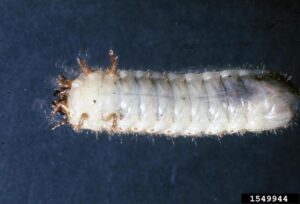
With summer now behind us, many of us are looking around our lawns and gardens and wondering what happened and what can be done. Hot summers aren’t just difficult on us, they are difficult on newly established plants and those plants that don’t have strong root systems. A healthy, established lawn should have a robust root system that can get it through hot, dry periods. But what is happening if you have an established lawn that still struggled during the summer? To understand what happened, we have to put on our detective hat and look for clues. The first step is to make sure that you have the right grass for your location. Cool season grasses such as fescue and perennial ryegrass are easily stressed by our hot summers and will thin out during dry periods. St. Augustinegrass, while a great choice for more shaded locations in Hoke County, doesn’t like full sun and so will often be attacked by insects such as chinch bugs during dry periods. Grass species well suited to our southeastern lawns include bermudagrass, centipedegrass, and zoysiagrass.
The next step is to make sure that the soil has the right pH, enough nutrients, and the grass can access those nutrients. A simple soil sample can determine your soil’s pH and its nutrient content. The NC department of agriculture and consumer services offers soil testing free of charge until Thanksgiving. Soil boxes and information is available at the cooperative extension office. We also want to make sure that our soil isn’t compacted and that the grass has a strong root system. When you dig up your grass, does it have short stubby roots? If so, you may have a problem with white grubs, the larval stage of beetles in the Scarab family. Some of the most common white grub species in our area include Japanese beetles, green June beetles, masked chafers, and May-June beetles. With the exception of green June beetles, these grubs are herbivores that love to munch on the roots of our grass.

If you suspect that you have a problem with white grubs in your lawn, it is important to determine their population size in early fall. Locate a sparse area of your lawn, dig up a square foot flap of soil, and look for grubs in the top four inches of your lawn’s roots. If, after doing this several times throughout your lawn, you find an average of 4 or more grubs, it is likely time for a treatment. These grubs have an annual life cycle and are smallest in the fall. As they grow, they cause more extensive damage to your lawn and are also more difficult to control. Green June beetles are very different than other white grubs and have the nasty habit of crawling to the soil surface to die after insecticide treatments. Because of this, it’s important to determine that you don’t have green June beetle grubs before treating. While all other white grubs crawl on their stomach using their legs, green June beetle grubs will crawl on their back with their legs in the air. This activity can help distinguish them from other species so that you do not spray at an inopportune time and have large numbers of grubs dying on the surface of your lawn.
There are two biological controls for white grubs. The first biological control treatment is the milky spore bacteria which only infect the most damaging white grub, Japanese beetles. While this biological control is effective in many locations, it prefers soils with a pH between 6 and 7, higher than many soils here in the Sandhills. The second biological control is another bacterium which goes by the trade name grubGoneG. While grubGoneG affects all beetles, it is unknown how effective it is in the Sandhills region. Other natural killers of white grubs include birds and moles, both of which destroy your lawn as they hunt for food. A few insecticides that are effective against white grubs include chlorantraniliprole (Acelepryn), clothianidin (Arena), imidacloprid (Merit), thiamethoxam (Meridian), trichlorfon (Dylox, Proxol), and dinotefuran (Zylam). For rates and all other information, check the label on your insecticide. When applying insecticides, remember that you will get the best control by applying your insecticide in the fall while grubs are still small.
If you’d like more information regarding lawn maintenance or white grubs, please contact Robby Brockman at the Hoke County Cooperative Extension Service, 645 East Palmer Street, Raeford. By phone at 910-875-3461 or email at robby_brockman@ncsu.edu
